List
1. Introduction
1.1. Abstract Data Types(ADTS)
- ADT definition: a set of objects together with a set of operations Abstract data types are mathematical abstractions; nowhere in an ADT‟s definition is there any mention of how the set of operations is implemented. A set of objects and a set of operations. Abstract data types are mathematical abstractions; In the definition of ADT, there is no mention of how to implement the operation set.
1.1.1. data object
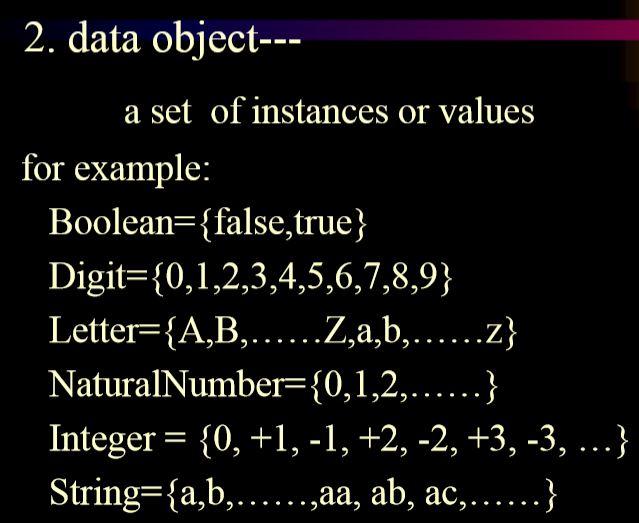
1.1.2. data structure

2. Linearity table
- A linear table is a collection of objects or values

- The above is the method to be implemented.
2.1. Methods to implement linear table
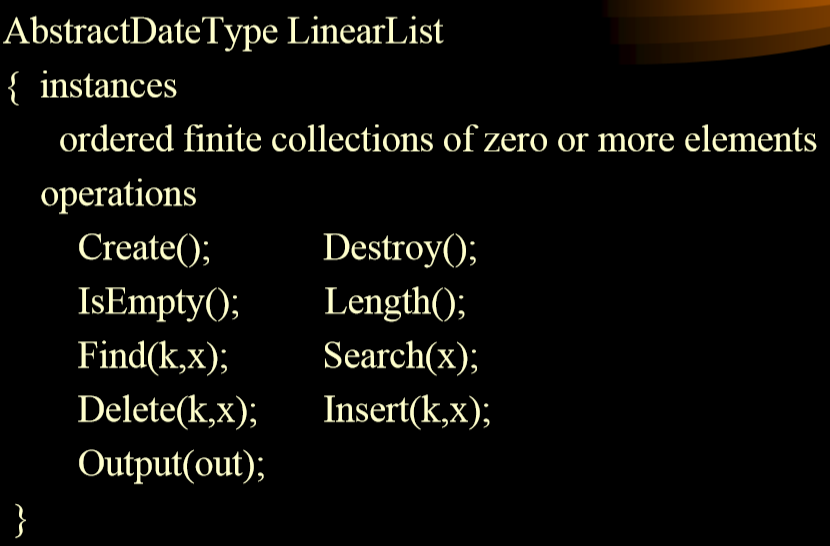
2.2. Different implementations of linear tables
2.2.1. Simple array implementation of linear table
- (e1,e2,...... en), that is, the array requests a continuous piece of memory from the system, and the size of the data is determined by the programmer.
- each position of the array is called a cell or a node mapping formula: location(i)=i-1
- The complexity of extracting an element from the linear table stored in the array type is O(1).
- Generally, we place values of the same type in the linear table.
Some methods
- Time complexity O(n) and average algorithm complexity O((n+1)/2) of sequential Search(x)
- Average data access times: n/2
- delete the k'th element and return it in x
- The algorithm complexity in the worst and average cases is O(n)
- Average number of data moves: (n-1)/2
- Insert operation insert(x,i)
- Average number of data moves: n/2
2.2.2. A linked list implements a linear table
- Features: not continuous memory in memory.
- A linked list node stores a pointer and data.
- Pointers in java cannot be added or subtracted to prevent some system problems. In C + +, addition and subtraction can be performed.
- The last pointer points to null
Partial operation
- Delete operation: Delete(index,x)
- Delete the first node: re point to the first pointer, and delete the dereferenced object in C + +. Manual release needs to write down the position first.
- Delete intermediate node: query first and then delete
- before.link = before.link.link
- Insert operation: insert(index,x)
- Insert an element at the beginning of the linear table: first insert an element, and then point the head pointer to the head.
- Insert an element in the middle of the linear table: first query to find the corresponding element
2.2.3. Single linked list with header element
- There is a Header node, Header: there is no data in this node, and then the pointer points to the first element
3. java implementation of linear table
- ListNode: class representing the node
- LinkedList: a class representing the table itself
- LinkedListItr: class representing cursor position
- Are part of the package DataStructure
3.1. ListNode
class ListNode {
object element;
ListNode next;
ListNode( object theElement) {
this( theElement, null);
}
ListNode( object theElement, ListNode n) {
element = theElement;
next = n;
}
}
3.2. LinkedListItr
- Encapsulate the corresponding pointer operation
public class LinkedListItr {
LinkedListItr( ListNode theNode) {
current = theNode;
}
public boolean isPastEnd( ) {
return current == null;
}
public object retrieve() {
//Get current node data
return isPastEnd( ) ? null : current.element;
}
public void advance( ) {
if( ! isPastEnd( ) ) current = current.next;
}
ListNode current;
}
3.3. LinkedList
public class LinkedList {
private ListNode header;
public LinkedList( ) {//Here is a single linked list with header node. If there is no header, it should be heder = null
header = new ListNode( null );
}
public boolean isEmpty( ) {
return header.next = = null ;
}
public void makeEmpty( ) {
header.next = null;
}
//Itr pointing to head pointer
public LinkedListItr zeroth( ) {
return new LinkedListItr( header );
}
//Itr pointing to the first item
public LinkedListItr first( ) {
return new LinkedListItr( header.next );
}
public LinkedListItr find( object x )
public void remove( object x )
public LinkedListItr findPrevious( object x )
public void insert( object x, LinkedListItr p )
}
3.4. Implementation of some methods
3.4.1. Print linear table
//Method to print a list
public static void printList( LinkedList theList ) {
if ( theList.isEmpty( ) )
System.out.print ("Empty list");
else {
LinkedListItr itr = theList.first();
for(;! Itr.isPastEnd(); itr. Advance( ) )
System.out.print(itr.retrieve() + " " );
}
System.out.println();
}
3.4.2. Find specific items
public LinkedListItr find (object x) {
ListNode itr = header.next;
while ( itr != null && !itr.element.equals( x ))
itr = itr.next;
return new LinkedListItr( itr );
}
- Time complexity O(n)
3.4.3. Remove node
public void remove( object x ) {
LinkedListItr p = findprevious( x );
if( p.current.next != null )
p.current.next = p.current.next.next;
}
- Time complexity O(1)
- You can treat the findPrevious operation as a separate operation, not a part of this operation.
3.4.4. Find previous node
public LinkedListItr findPrevious( object x ) {
ListNode itr = header;
while( itr.next !=null && !itr.next.element.equals( x )) itr = itr.next;
return new LinkedListItr( itr );
}
- Time complexity O(n)
3.4.5. Example: polynomial summation
- We sum two polynomials
- Method 1: we align and add
- Method 2: we use arrays to store indices and parameters.
public class Polynomial {
public Polynomial( ) {
zeroPolynomial( );
}
public void insertTerm( int coef, int exp )
public void zeroPolynomial(){//Empty polynomial
for( int i = 0; i<=MAX-DEGREE; i++)
coeffArray[i] = 0;
highPower = 0;
}
public Polynomial add( Polynomial rhs ){
Polynomial sum = new Polynomial( );
sum.highPower = max( highPower, rhs.highPower );
for( int i = sum.highPower; i>=0; i--)
sum.coeffArray[i] = coeffArray[i] + rhs.coeffArray[i];
return sum;
}
public Polynomial multiply( Polynomial rhs ) throws Overflow
public void print( )
public static final int MAX-DEGREE = 100;
private int coeffArray[ ] = new int [MAX-DEGREE + 1];
private int highPower = 0;
}
4. Single cycle linked list
- The next of the last one points to the first or header
4.1. example
-
josephus problem
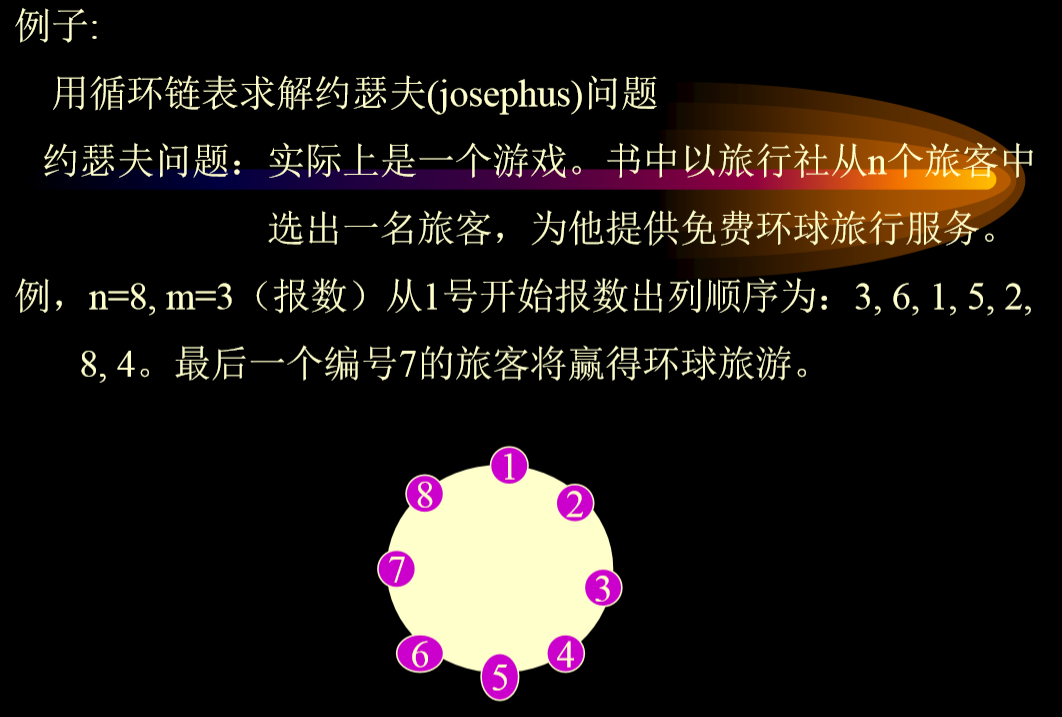
-
Problem solving:
- Use a new single linked list to record.
- p is the last point to reduce the complexity of insertion

w = m;
for( int i = 1; i<= n-1; i++) {
for (int j = 1; j<=w-1; j++) rear = rear.link;
if (i = = 1) {
head = rear.link ; p = head;
} else {
p.link = rear.link;
p = rear.link;
}
rear.link = p.link;
}
P.link = rear; rear.link = null;
4.2. Relevant calculation formulas of circular queue
- We might as well set front as the head pointer, rear as the tail pointer, and m as the maximum capacity of the queue.

-
Join the team: rear = (rear + 1)% m
-
Outgoing: front = (front + 1)% m
-
front = rear
-
Full team: front = (rear + 1)% m
-
Number of elements in the current queue: n = (Rear - front + m)% m
-
Find the position of the team head pointer: (Rear - length + 1 + m)% m
5. Polynomial problem
5.1. Array implementation of linear table
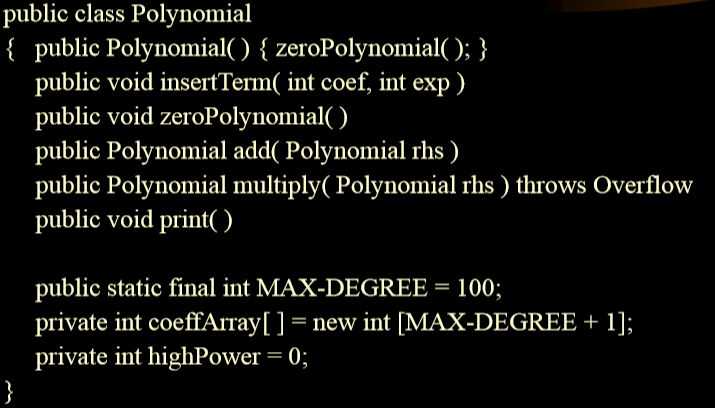
5.1.1. Partial method
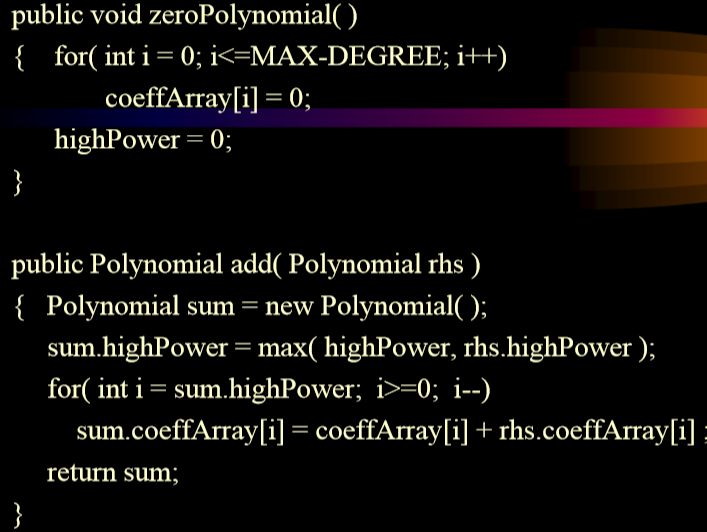
multiplication
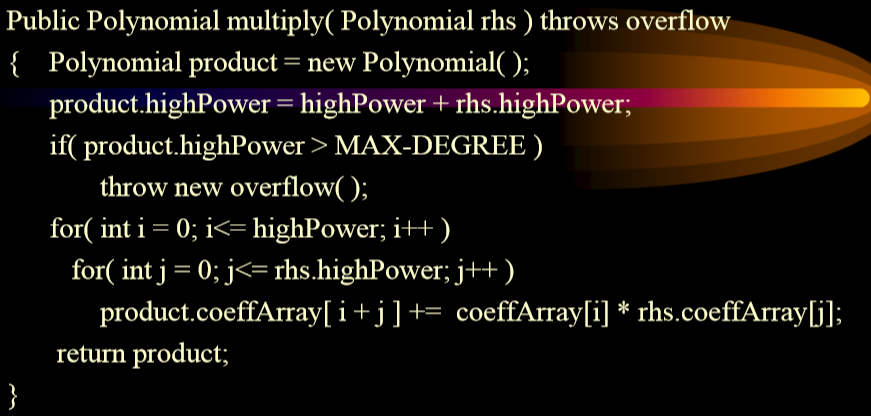
5.2. Single linked list implementation of linear table
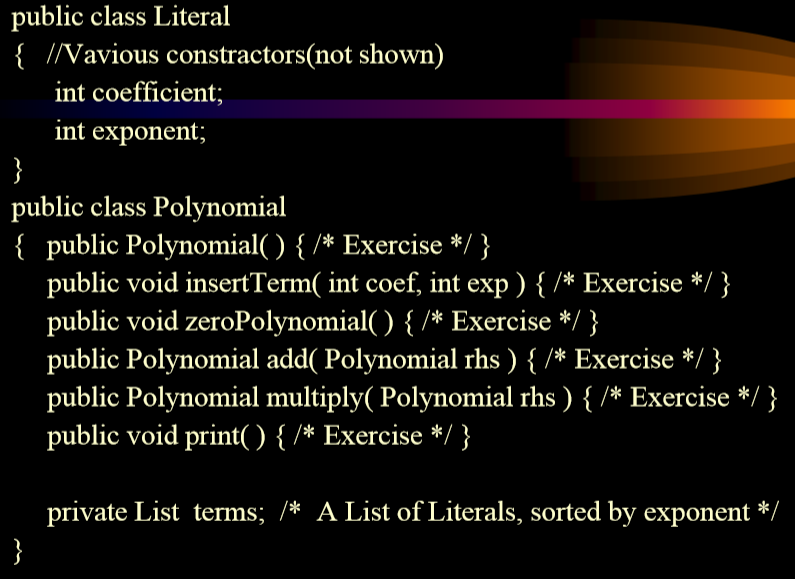
5.2.1. Polynomial addition
- Store the coefficients and indexes of non-zero indexes, so no node is composed of three fields.
- (coef + exp)(item) + link
- In the specific implementation, do not re apply for nodes, and make full use of the nodes of the original two linked lists.
- Method: Set 4 reference variables:
- PA, Pb, PC, P (required for C + +)
Arithmetic steps
- Initialization: PC, PA, Pb
- When both pa and pb have entries, pc always points to the last node of the result list when adding.
- Exponential equality (pa. exp==pb. exp)
- Corresponding coefficient addition: Pa. coef = Pa. coef + Pb coef ;
- P = Pb (required for C + +);
- pb advance;
- if (the coefficient addition result is 0) {P = Pa; PA forward;} Else {PC. link = Pa; PC = Pa; PA forward}
- Exponential inequality Pa. exp < Pb Exp / / Pb to insert the linked list of results
- {PC. link = Pb; PC = Pb; Pb forward}
- Exponential inequality Pa. exp > Pb Exp / / PA to insert the linked list of results
- {PC. link = Pa; PC = Pa; PA forward}
- Exponential equality (pa. exp==pb. exp)
- When one of the two linked lists is empty, the other linked list can be linked into the result linked list. if(pb is empty) {pc. link=pa;} else pc. link=pb;
Algorithm complexity: O(m+n)
6. Two way linked list

- When deleting, the middle is different
6.1. delete
- Delete the first node

- Delete middle

6.2. insert
- Insert from scratch
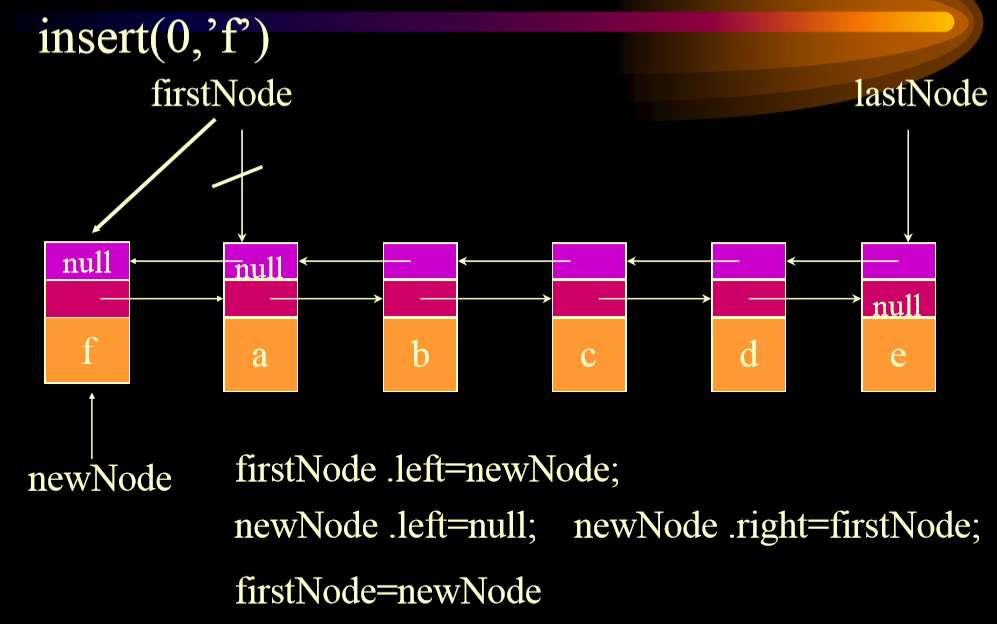
- Insert from
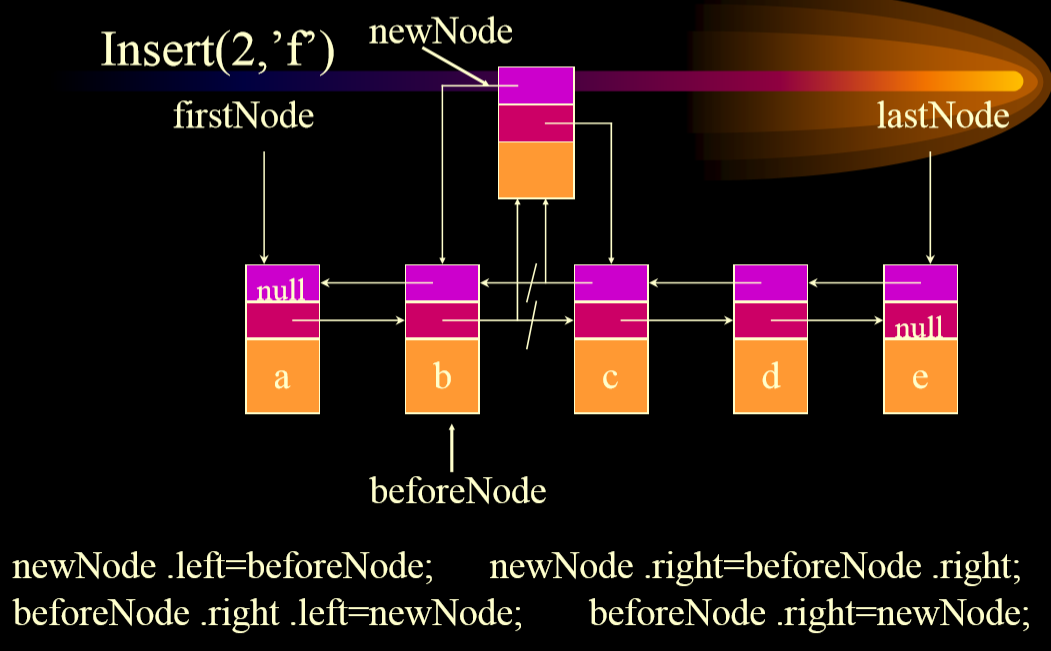
6.3. Deformation: bidirectional circular linked list
- Bidirectional linked list with header
- Bidirectional linked list without header
- Empty bidirectional linked list with header
7. Example: 2009 postgraduate entrance examination questions
- Algorithm idea: Double pointers. The first pointer runs k steps first, then runs the second pointer, and the first and second run forward together.
8. Static linked list
- Static linked list is a single linked list implemented by array.

- In the system, for the system, memory is managed by the system like this.
- If next is 0, it is equivalent to null
8.1. Implementation of static linked list

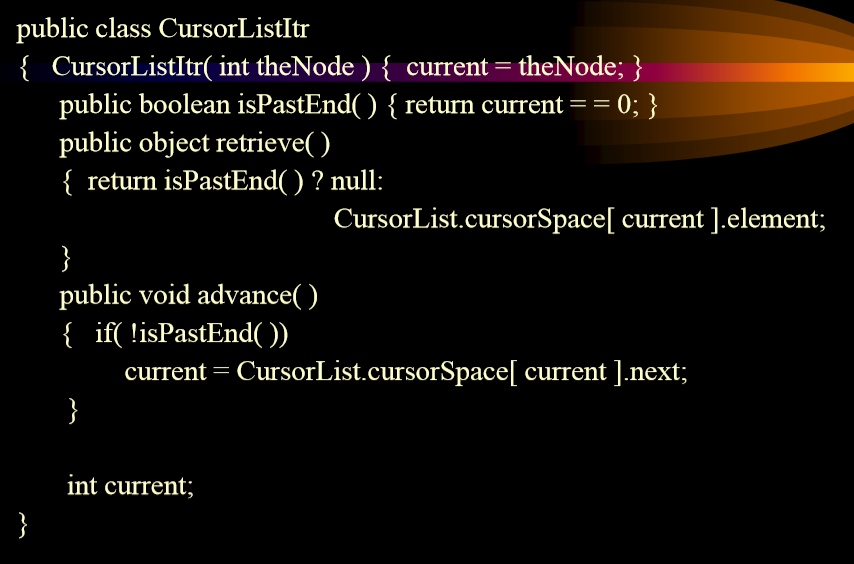
8.2. Implementation code
//Class skeleton for CursorList
public class CursorList {
private static int alloc( )
private static void free( int p)
public CursorList( ) { header = alloc( ); cursorSpace[ header ].next = 0; }
public boolean isEmpty( ) { return cursorSpace[ header ].next = = 0; }
public void makeEmpty( )
public CursorListItr zeroth( ) { return new CursorListItr( header ); }
public CursorListItr first( ) { return new CursorListItr( cursorSpace[ header ].next ); }
public CursorListItr find( object x )
public void insert( object x, CursorListItr p)
public void remove( object x )
public CursorListItr findPrevious( object x )
private int header; static CursorNode [ ] cursorSpace;
private static final int SPACE-SIZE = 100;
static {//There is only one static variable for a class
cursorSpace = new CursorNode[ SPACE-SIZE ];
for( int i = 0; i<SPACE-SIZE; i++) cursorSpace[ i ] = new CursorNode( null, i + 1 );
cursorSpace[ SPACE-SIZE-1].next = 0;
}
}
- The static part is the responsibility of the system manager
- The non static part is user's
8.3. How does the static linked list determine that there is still memory that can be allocated
- Store the remaining memory in a static linked list first.
8.4. Implementation of some methods
private static int alloc( ) {
int p = cursorSpace[ 0 ].next;
cursorSpace[0].next = cursorSpace[p].next;
if( p == 0 ) throw new OutOfMemoryError( ); return p; }
private static void free( int p ) {
cursorSpace[p].element = null;
cursorSpace[p].next = cursorSpace[0].next;
cursorSpace[0].next = p; }
public CursorListItr find( object x ) {
int itr = cursorSpace[ header ].next;
while( itr != 0 && !cursorSpace[ itr ].element.equals( x ) )
itr = cursorSpace[ itr ].next;
return new CursorListItr( itr );
}
public void insert( object x, CursorListItr p ) {
if( p != null && p.current != 0) {
int pos = p.current;
int tmp = alloc( );
cursorSpace[ tmp ].element = x;
cursorSpace[ tmp ].next = cursorSpace[ pos ].next;
cursorSpace[ pos ].next = tmp;
}
}
public void remove( object x ) {
CursorListItr p = findPrevious( x );
int pos = p.current;
if( cursorSpace[ pos ].next != 0 ) {
int tmp = cursorSpace[ pos ].next;
cursorSpace[ pos ].next = cursorSpace[ tmp ].next;
free( tmp );
}
}
public void makeEmpty( ) {
while( !isEmpty( ) )
remove( first( ).retrieve( ) );
}